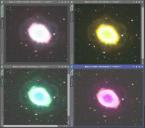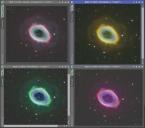Howdy, Stranger!
It looks like you're new here. If you want to get involved, click one of these buttons!
In this Discussion
HDRMST and sequence of steps
With the moon full and clear skies (why can't that happen when new moon?) I decided to get some narrow band data on M57, and have a fair amount now and experimenting.
With a regular stretch both Oiii and Ha are just big white blobs, with a faint halow, Sii more ring like.
So armed with an old memory of your videos on HDRMST I watched them again, and dove in and got ... interesting results. I don't want to get distracted by the details but rather ask a general question.
HDRMST needs a stretched image. Other functions, such as denoise (I usually use TGV) and Decon need linear. The RGB combine, notably if you want to build a synthetic luminance, can be done either before or after stretch but with quite different results. But these combinations lead to some questions regarding positioning HDRMST...
HDRMST can work on both the mono images and the composite. I also understood your point of using a preview to have HDRMST have visibility of only the main structure. Is there a similar argument for different channels -- should one do all three at once because of some cross-channel analysis it is doing, or is it better to fine tune each separately before combining? Or is it more "try both and see which works best for a given image"?
Running it on individual channels also complicates PCC as I've never had luck running it on a stretched image, and have had fairly good luck even with NB on the linear, getting reasonable if not correct star colors.
If using linear processes like deconv and tgv (at least I've always seen them done on linear images), it means that they are running on a big white blob at least as far as the human can see. Is there some preferred way to position those relative to the HDRMST? Really there are two parts to the question (and mostly with respect to deconv). The primary one is whether deconv can "see" the structures it enhances well before the HDR process is run, i.e. is some partial stretch (i.e. left mostly but not entirely linear) needed to give deconv adequate contrast to work with, and secondly the human evaluating the deconv run really cannot tell much before the HDR process, other than picking a good stf preview, is there a process that helps this?
Finally, really good timing on that video for the new substitute script. Made this much easier!
Linwood
PS. Here for your amusement is are three pallets before and after HDRMST, with no other processing or color work, just to show its potential. I still need to fine tune, these were run on the stretched composite with minimal adjustment (5 layers, Gaussian 11, manual midtone 0.36). For these I did a combine, then PCC, then STF/Histogram stretch and HDRMST, no noise reduction or deconv, just looking at colors and to see how much structure it can find.


before.jpg
1046 x 925 - 118K


After.jpg
1048 x 927 - 95K

Comments